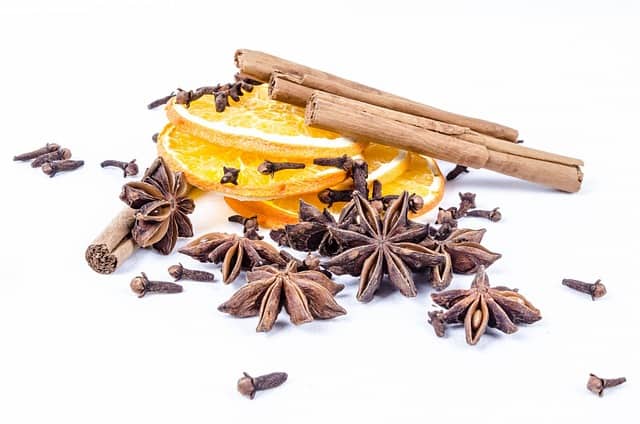You can definitely combine cinnamon and cloves in your culinary creations in both sweet and savory recipes. Cinnamon and cloves complement each other well, adding warmth, depth, and a touch of sweetness to dishes.
Below are some examples of dishes that combine cinnamon and cloves along with a comparison of the two spices and what each offers.
Dishes To Combine Cinnamon And Cloves
- Mulled Cider: Simmer apple cider with cinnamon sticks, cloves, and other spices for a fragrant and cozy beverage.
- Spiced Chai Tea: Infuse black tea with cinnamon, cloves, ginger, and other spices to create a flavorful and aromatic cup of chai.
- Moroccan Tagines: The combination of cinnamon and cloves is commonly used in Moroccan tagines, adding richness and complexity to slow-cooked stews.
- Baked Apples: Sprinkle a mixture of cinnamon, cloves, and sugar over halved apples before baking for a warm and comforting dessert.
- Spiced Rice Pudding: Enhance the flavor of rice pudding by incorporating cinnamon and a hint of cloves into the creamy mixture.
- Spiced Nuts: Toss mixed nuts with a blend of cinnamon, cloves, sugar, and melted butter, then bake until fragrant and crunchy for a delicious snack.
- Roasted Vegetables: Add a pinch of cinnamon and cloves to roasted root vegetables like carrots or sweet potatoes for a unique and flavorful twist.
Remember, the combination of cinnamon and cloves can be adjusted to suit your personal taste preferences. Feel free to experiment with different ratios and explore their delicious pairing in various dishes.
Cinnamon And Cloves Comparison
Here’s a comparison table for cinnamon and cloves:
| Cinnamon | Cloves | |
|---|---|---|
| Flavor Profile | Sweet, warm, slightly spicy | Strong, pungent, slightly sweet |
| Culinary Uses | Baked goods, desserts, spice blends, hot beverages | Baked goods, pickling, stews, spice blends, hot beverages |
| Aroma | Sweet, aromatic | Intensely aromatic, slightly fruity |
| Color | Light to dark brown | Dark brown |
| Health Benefits | Anti-inflammatory, antioxidant properties | Antimicrobial, digestive aid, antioxidant properties |
| Culinary Forms | Ground cinnamon, cinnamon sticks | Whole cloves, ground cloves |
| Key Compounds | Cinnamaldehyde | Eugenol |
| Origins | Bark of the Cinnamomum tree | Flower buds of the Syzygium aromaticum tree |
| Pairings | Apples, chocolate, nuts, oats | Citrus fruits, ham, beef, onions, ginger |
| Cuisine | Widely used in both sweet and savory dishes globally | Commonly used in European, Indian, and Middle Eastern cuisines |
| Intensity | Mild to moderate | Strong and distinct |
This table provides a comparison of the key characteristics, flavor profiles, culinary uses, and health benefits of cinnamon and cloves. Keep in mind that personal taste preferences may vary, and the intensity of flavors can be adjusted by the amount used in recipes.
Experimenting with different combinations of cinnamon and cloves can help you create delightful and flavorful dishes.
How To Use Cinnamon And Cloves In Cooking
Cinnamon and cloves can be used in various forms depending on the recipe and personal preference. Here are the common forms in which cinnamon and cloves are used:
Cinnamon
- Ground Cinnamon: This is the most common and readily available form of cinnamon. Ground cinnamon is used in baking, desserts, spice blends, and hot beverages.
- Cinnamon Sticks: These are the dried bark of the cinnamon tree rolled into stick form. Cinnamon sticks are often used to infuse flavors in hot beverages, simmered in stews or tagines, or used as a garnish.
Cloves
- Whole Cloves: These are the dried flower buds of the clove tree. Whole cloves are used in pickling, stews, spice blends, and to stud ingredients like ham or onions for slow-cooked dishes.
- Ground Cloves: Ground cloves are made by grinding whole cloves into a powder. This form is commonly used in baking, spice blends, and adding a concentrated flavor to dishes.
Both cinnamon and cloves can be used in either ground or whole form depending on the recipe requirements. Ground forms are more commonly used for even distribution of flavors, while whole forms are used for infusing and garnishing purposes. It’s important to note that ground spices tend to release flavors more quickly, while whole spices provide a slower infusion of flavors.
Final note: Check out my article called What Is the Difference Between Cinnamon and Cassia to learn more about an alternative to cinnamon to consider for your cooking.

